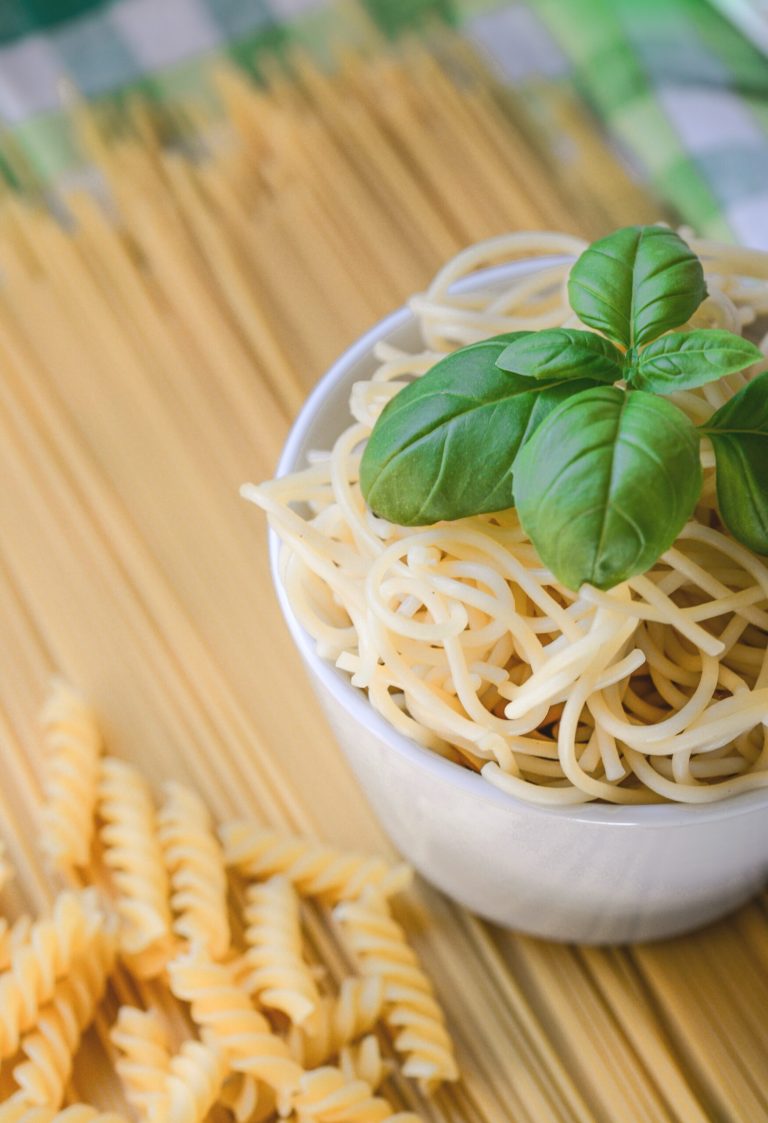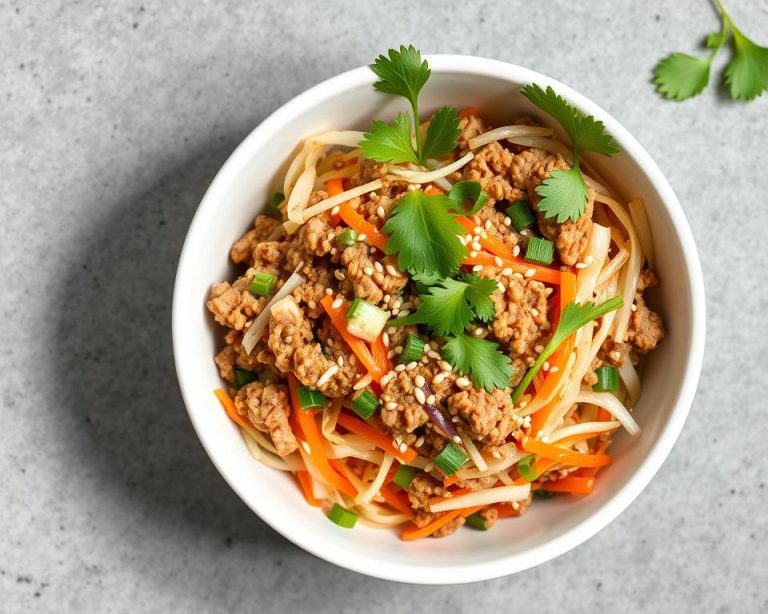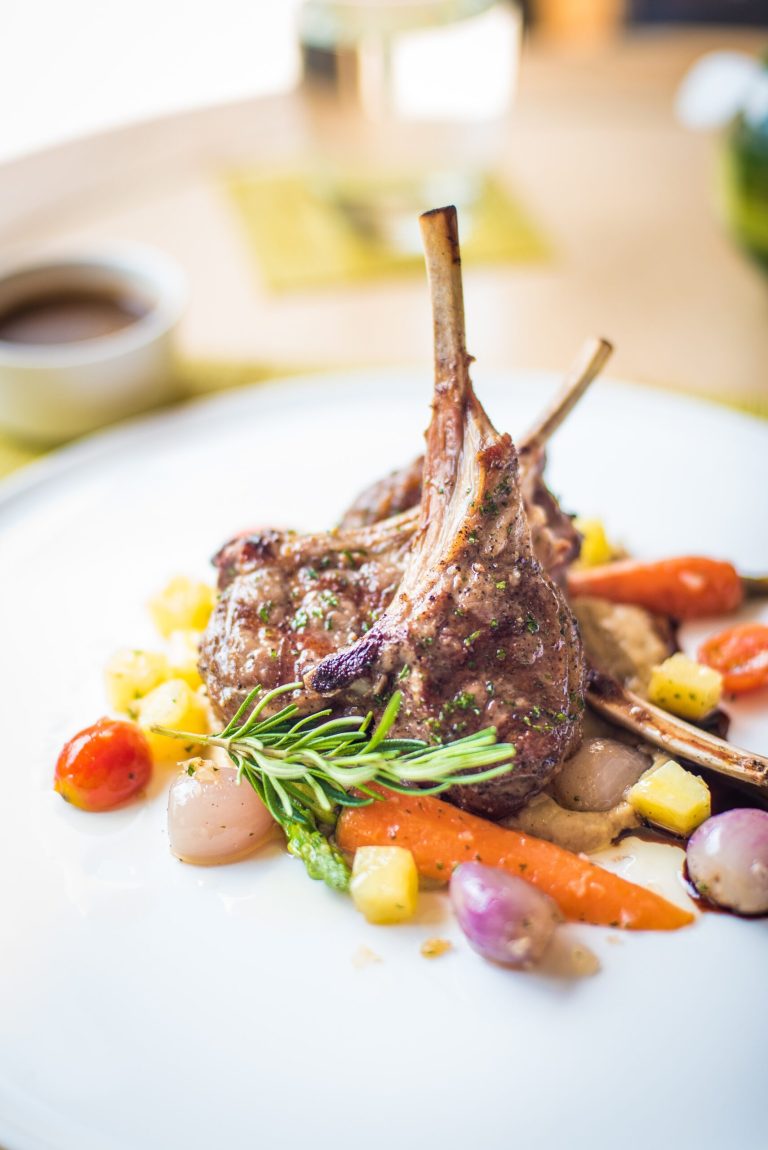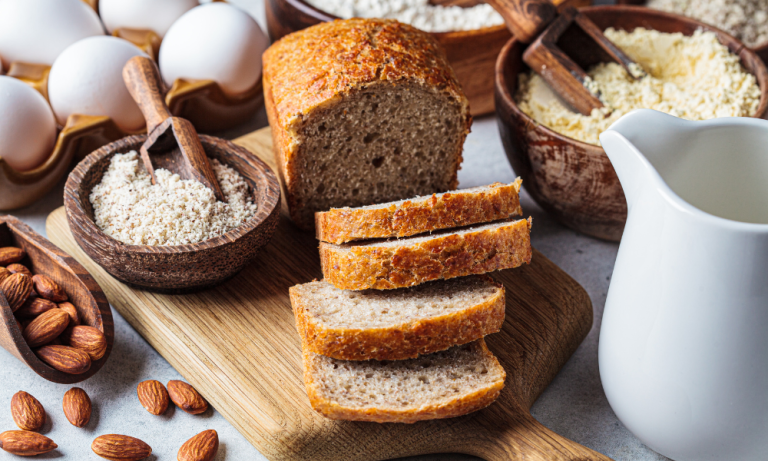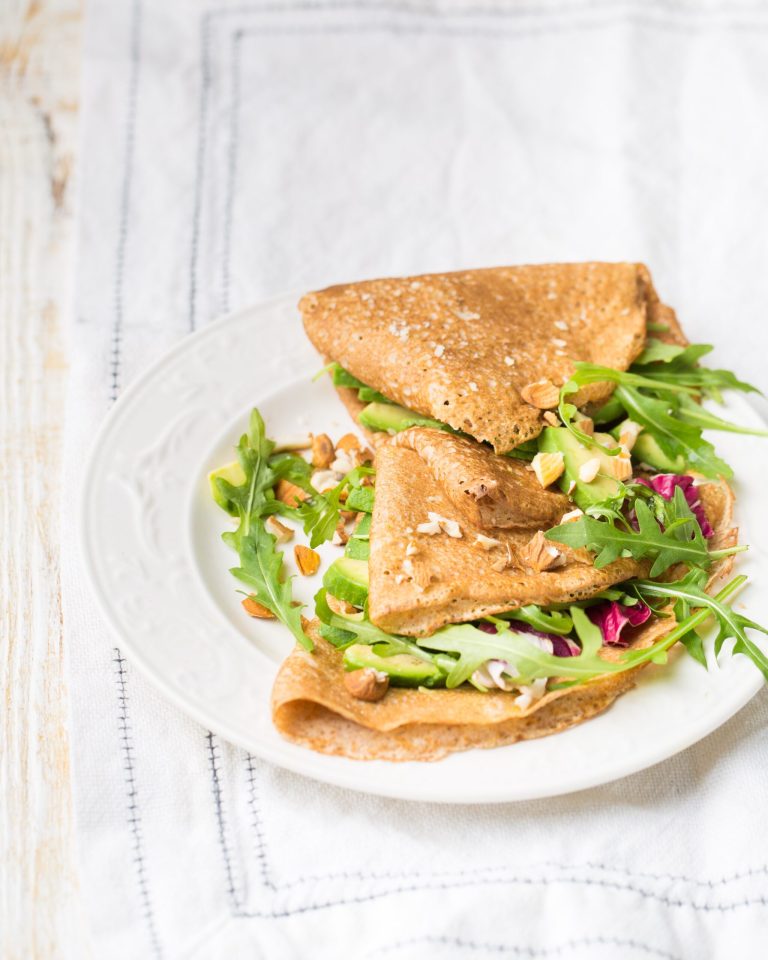Keto Pasta Recipe | 5-Ingredient
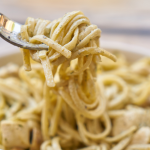
Keto Pasta Recipe: How to Make Low Carb Noodles That Taste Like the Real Thing
I still remember the first time I craved a big bowl of pasta after starting my keto diet. I glanced at my old stash of wheat flour and realized that sticking to my plan meant I had to get creative. That’s when I decided to explore homemade keto pasta. I wanted noodles that tasted like the real thing—chewy, comforting, and perfect for my favorite pasta sauce. After a few experiments, I finally succeeded in making a keto pasta recipe that satisfied my cravings without the carbs overload. Today, I’m excited to share everything I’ve learned, so you can make keto noodles at home and enjoy them as much as I do.
Table of Contents
What Are the Key Ingredients for Keto Pasta?
I’ve discovered that the key ingredients for keto pasta often revolve around low carb alternatives, cheeses, and a little creativity. Unlike traditional pasta, which relies on wheat flour, this version uses a combination of almond flour and other binding agents to get that familiar pasta texture. Even though we skip the wheat pasta route, the final result can feel just as satisfying.

Understanding Low Carb Alternatives to Wheat Flour
When I began experimenting, I realized I needed to move away from wheat flour and focus on better replacements. Almond flour quickly became one of my go-to options for creating low carb pasta noodles. It’s lower in net carbs per serving compared to standard wheat flour. Because almond flour has more fat and fewer carbs, it’s a great choice if you’re aiming for the lowest carbohydrate pasta possible.
🔥Pro Tip: There are many keto-friendly flours available on the market. However, always check the label for total carbs, as different brands can vary. Some people also like using a brand of lupin flour, which can help reduce net carbs further. Just note that each flour choice may slightly change the taste and texture of your dough.
Ingredients in This Recipe ⬇️
How to Use Almond Flour in Your Recipe
Almond flour is typically the base for most keto pasta recipes. It binds nicely when combined with other ingredients, yet still rolls out well. To avoid grittiness, I recommend using a fine, blanched variety.
🍝Chef’s Tip: If your dough seems too crumbly, try adding a little more moisture, such as an extra egg or a bit of olive oil. The goal is to form a smooth ball of dough that you can roll out easily.
The Role of Cheese in Keto Noodles
In many keto pasta noodles, cheese acts as both a flavor enhancer and a binding agent. Mozzarella cheese is a favorite because it melts into a pliable texture. Sometimes I add a sprinkle of Parmesan for a salty punch. You can also consider two ingredients that often appear in keto cooking: cream cheese and shredded mozzarella cheese. They bring chewiness to your keto noodles made at home.
Pro Advice: Melt your cheese slowly over low heat before adding any almond flour, so you don’t burn or clump your mixture. Doing so helps create a cohesive dough that resembles fresh pasta rather than a crumbly mess.

How to Make Keto Pasta at Home?
When I set out to make keto noodles, I wanted something that actually felt like regular pasta. I tried countless methods—everything from a pasta maker to hand-cutting the strips. Below, I’ll walk you through what I’ve found to be the most reliable steps.
Step-by-Step Guide to Preparing Keto Pasta Dough
- Gather Your Ingredients
I use almond flour, shredded mozzarella cheese, eggs, a pinch of salt, and sometimes a dash of keto flour if I want a firmer texture. - Melt and Mix
Gently warm the mozzarella cheese until it’s soft. Combine it with your almond flour and eggs. Make sure the dough forms nicely; you don’t want lumps or bits of unmelted cheese. This is when you truly make the dough come together. - Shape into a Ball
Form the dough into a ball of dough. If it feels sticky, dust your surface with a tiny bit of almond flour. If it’s too dry, add a spoon of water. Letting the dough rest for a few minutes can also help improve the texture. - Roll Out the Dough
Take your rolling pin and roll out the dough to your desired thickness. Remember, thinner dough often means more delicate noodles, but it can feel closer to real pasta when cooked.
🍝Chef’s Tip: If your pasta wasn’t holding together as well as you’d like, try adding a small amount of baking powder to the dough. This can give it extra elasticity.
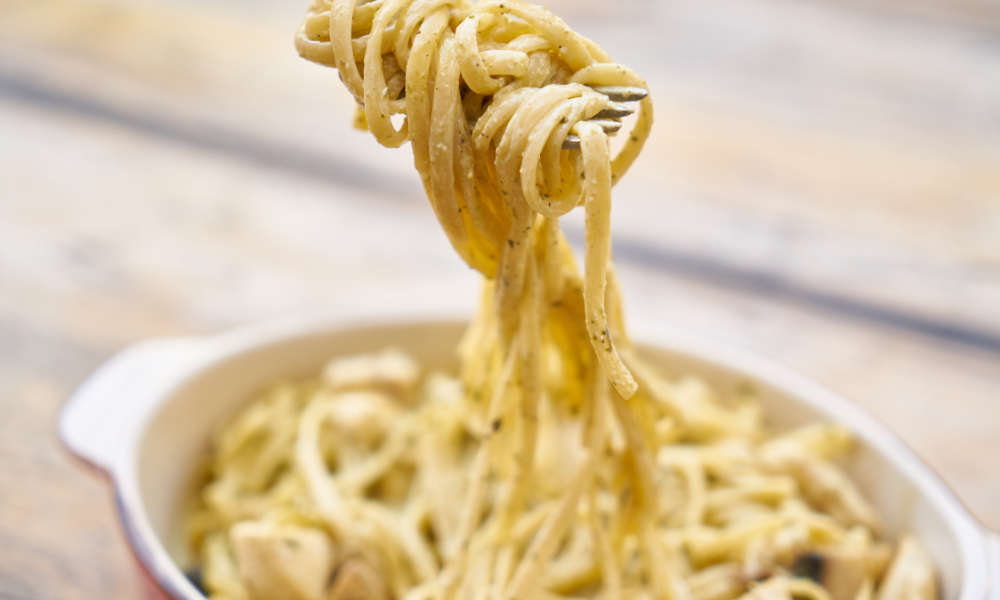
Using a Pasta Machine for the Best Texture
I once borrowed a pasta machine from a friend, and that’s when I realized how easy keto noodles can be. When you feed the dough through a pasta roller, you get uniform sheets that cook evenly. After the first pass, fold and repeat to achieve your best texture. Then, use the cutting attachment to shape the noodles.
Pro Advice: If you’re using a pasta machine, sprinkle a bit of almond flour on the rollers to prevent sticking. Keep adjusting the thickness setting until you get the thinness you desire.
Alternative Methods: Pasta Cutter or Extruder
Not everyone owns a pasta maker, so don’t worry if you need to try other methods. A simple pasta cutter can do the job. You can roll your dough into thin sheets and then use the pasta cutter to slice them into strips. For a fancier approach, a pasta extruder can shape your noodles into various forms.
🍝Chef’s Tip: If you choose a pasta cutter, cut the noodles right after rolling out your dough. If you leave the dough exposed too long, it might dry out at the edges, which makes slicing uneven.
What Are the Best Keto Noodles Recipes to Try?
Sometimes I like to switch up my meal plan by experimenting with different pasta dish ideas, from comforting lasagna noodles no flour style to fancy keto ravioli. Here are a few of my all-time favorites.

Simple Keto Lasagna without Flour
One of the first successful dishes I tried was a keto lasagna that skipped traditional noodles altogether. I used thin sheets of homemade dough—basically my standard keto pasta approach—to replace the lasagna noodles no flour option I was craving.
Pro Advice: Layer each sheet with ricotta cheese, ground meat, and your favorite marinara or alfredo sauce. Bake until bubbly. Because these are low carb noodles, they won’t soak up as much sauce, so keep an eye on the liquid levels.
Making Keto Ravioli with Low Carb Fillings
Another fun approach is keto ravioli. I make pasta dough as usual, roll it out, and cut it into squares. Then I place a small spoonful of filling (like spinach and ricotta) on each square before sealing the edges.
🍝Chef’s Tip: Use a fork to press down on the edges so they stay closed. It’s a great recipe if you want stuffed pasta that resembles the traditional version. You can also freeze a batch for later if you’d like.
Creating Delicious Low Carb Pasta Sauces
Every good pasta dish needs a memorable sauce. I love pairing my noodles with low carb pasta sauces that are simple yet flavorful. A creamy alfredo sauce can really highlight the subtle cheesy notes in my homemade dough, while a robust tomato-based sauce gives a hearty spin.
Pro Advice: If you’re aiming for easy keto cooking, make a simple sauce with crushed tomatoes, garlic, onion, olive oil, and Italian herbs. Season to taste, and you’ll have a quick topping ready in minutes.

Can You Freeze Keto Pasta?
Whenever I make a big batch, I love the idea of meal prep. The good news: you can freeze keto pasta. However, you’ll need to do it the right way to preserve flavor and texture.
How to Properly Freeze and Thaw Keto Noodles
- Shape Your Noodles
I like to cut the noodles before freezing so that everything’s ready when I want to cook them later. - Dust with Almond Flour
A light dusting helps prevent clumping. Spread them out in a single layer on a parchment-lined tray. - Freeze
Place the tray in the freezer for about an hour or two. Once the noodles are firm, transfer them to a freezer-safe container or bag. This is especially helpful if you want no carb pasta within reach for those busy weeknights.
🍝Chef’s Tip: You can freeze multiple portions so you only pull out what you need.

Maximizing Flavor and Texture After Freezing
When you’re ready to use your stored keto noodles, thaw them in the fridge or cook the noodles straight from frozen if you prefer a slightly firmer bite. The key is to check how long can pasta stay in the fridge or freezer. Generally, frozen noodles can last up to two months, but try to use them sooner for the best results.
Pro Advice: If you notice any excess moisture after thawing, pat them dry before cooking. This prevents a watery dish.
How Many Net Carbs Per Serving in Keto Pasta?
If you’re like me, you care about net carbs per serving because that’s the hallmark of staying on track with a keto diet. Counting net carbs typically involves subtracting fiber and sugar alcohols from total carbs, so your exact carb count depends on the brand of ingredients you use.
Comparing Keto Noodles to Traditional Pasta
In traditional pasta, wheat flour and wheat pasta variations result in much higher carb counts. Keto noodles, on the other hand, typically clock in with significantly fewer carbs. This difference is what makes me love this recipe so much.
🍝Chef’s Tip: Keep in mind that not all low carb pasta noodles are created equal. Some store-bought reduced carb pasta or no carb pasta might still contain hidden starches. Always read labels carefully to confirm your macros.
Calculating Net Carbs with Different Ingredients
To figure out your net carbs, add up the total carbs from almond flour (or your flour of choice) and cheese, then subtract any fiber. If you incorporate shirataki noodles or zucchini noodles in place of the dough, that number could drop even more.
Pro Advice: Many keto cooks rely on a recipe card with precise nutritional info. Use that data to compare different ingredient keto pasta ideas. Then pick whichever version best fits your macros.
Chef’s Table: My Personal Comparison of Pasta Substitutes
Below is a table comparing a few pasta alternatives I’ve tried. Each offers different textures, flavors, and cooking methods.
| Pasta Alternative | Texture | Typical Net Carbs | Special Notes |
|---|---|---|---|
| Homemade Keto Pasta (almond flour) | Chewy and sturdy | Approx. 4-6g per serving (depends on recipe) | Feels close to real pasta, freezer-friendly |
| Zucchini Noodles | Light, watery | ~2g per cup | Quick to cook, may release extra moisture |
| Shirataki Noodles | Slippery, slightly chewy | ~1-2g per serving | Often called “miracle noodles,” good option if in a hurry |
| Egg Noodles (keto-style) | Firm but can be rich | Varies by ingredients | Usually needs cheese or extra binding to hold together |
Pro Advice: Noodles work differently in terms of sauces. Zucchini may get soggy, while shirataki noodles might need rinsing to remove their natural aroma.
My Personal Experience and Common Questions
Before we wrap up, here are some frequently asked questions I’ve encountered. I followed the recipe for the first time with skepticism, but the end result convinced me that you can indeed make keto pasta that tastes wonderful. So if you’re curious about details like how to boil the noodles or ways to make keto noodles with a rolling pin, keep reading.
FAQ
- Q: Is there a specific pasta sauce that complements homemade keto pasta?
A: I love pairing my noodles with a creamy alfredo sauce, but a simple marinara also works perfectly. I recommend low carb pasta sauces to keep your meal keto-friendly. - Q: How do I make sure the dough doesn’t fall apart when shaping?
A: Add a pinch of psyllium husk powder to the dough or an extra egg if it’s too crumbly. Make sure the dough is at room temperature before you roll it out. - Q: Can I store leftover cooked pasta in the fridge?
A: Yes, but be aware of how long can pasta stay in the fridge. Usually around 2-3 days is fine. After that, it may start losing its texture and flavor. - Q: Do I need any special tools to make pasta without wheat flour?
A: Using a pasta machine or pasta roller gives you the best texture, but you can also use a rolling pin and a pasta cutter. If you like more advanced shapes, a pasta extruder could be helpful. - Q: I’ve seen many keto cooks using shirataki noodles. Are they better than homemade?
A: It depends on personal taste. Shirataki noodles are convenient but can have a rubbery texture. If you want something closer to real pasta, a homemade dough might be your best bet. - Q: Have you tried making stuffed pasta like keto ravioli?
A: Absolutely. It’s one of my favorite ways to enjoy comforting meals like pasta dish lasagna or keto ravioli. Just seal them well to avoid leaks. - Q: Is it possible to make keto noodles that taste like pasta if I skip cheese?
A: Yes, but you might need more almond flour and perhaps another binder. Cheese really helps achieve the chewy bite that many keto pasta lovers enjoy. - Q: What if I want to bring my pasta back to a slightly softer texture after freezing?
A: You can let it thaw in the fridge overnight. If the pasta is cooked, add a bit of sauce and gently warm it on the stove, so it rehydrates. - Q: Can I create lasagna noodles no flour style without a pasta maker?
A: Yes. You can roll out the dough by hand. Just use a rolling pin, then cut the noodles right into rectangular sheets. - Q: Do these noodles taste like the real thing?
A: While they may not be identical to traditional pasta, they come pretty close. For many keto fans, this is the best keto solution for satisfying those noodle cravings. - Q: Are there any good pasta brands that sell keto-friendly versions?
A: Some companies advertise reduced carb pasta, but always check labels for hidden ingredients. I prefer to make pasta from scratch so I know exactly what’s in it. - Q: Can I create egg noodles by just mixing eggs and almond flour?
A: You can make keto noodles that way, but adding cheese often improves the texture. If you want egg noodles specifically, focus on a higher egg ratio. - Q: Should I bring water to a rapid boil before cooking?
A: Absolutely. Once you boil the noodles, keep an eye on them because they usually cook faster than traditional pasta is cooked. This is especially true when dealing with homemade dough. - Q: Is it possible to create a free keto meal plan around this pasta?
A: Yes, many keto enthusiasts build entire weekly menus using different variations of pasta substitutes. Combining homemade noodles with sauces, proteins, and vegetables can diversify your diet. - Q: Does letting the dough rest really matter?
A: It can. Resting allows the ingredients to meld, making the dough easier to roll out and shape. - Q: How can I get that al dente bite?
A: Cook the noodles just until they start to float or get slightly translucent. Taste-test along the way to see if they reach that al dente sweet spot. - Q: Are there two ingredients to watch closely when making keto pasta noodles?
A: Yes—almond flour and cheese. They form the core that keeps your dough cohesive. If either is too low in quality, you might not get the sturdy texture you want. - Q: Does it taste like regular pasta enough to fool my family?
A: I’d say it’s pretty close to like regular pasta, though everyone’s palate is different. I’ve had family members say, “This tastes so much like pasta, I barely notice a difference.” - Q: Did you ever find a good pasta brand that equals your homemade version?
A: Honestly, I haven’t found a store-bought product that matches homemade quality. Making your own dough typically yields the best texture. - Q: Is it okay if I skip the cheese or use dairy-free cheese for my keto pasta noodles?
A: You can experiment with dairy-free options, but the final texture might change. Some people love this recipe with dairy-free mozzarella substitutes, but be aware it might not be like the real thing.
Craving something sweet after your low carb meal? Don’t miss our keto ice cream recipe — creamy, sugar-free, and absolutely satisfying.
Or start your day strong with this fluffy keto bread for breakfast — perfect with eggs or on its own.
Conclusion
its skinny pasta, so this low carb pasta recipe is perfect for anyone craving low-carb pasta, a recipe using minimal ingredients that recipe yields a hearty yet guilt-free meal.
Making keto pasta at home was a game-changer for me, especially when I craved that comforting feel of a pasta dish. With simple ingredients and the right technique—like using a rolling pin or pasta maker—you can produce a good pasta alternative that won’t derail your progress. Whether you’re aiming for keto ravioli or just want to make keto noodles for a quick dinner, this approach can satisfy those cravings for noodles right away.
love this recipe because it combines the joy of traditional pasta with all the benefits of staying low-carb. best keto tips always emphasize creativity in the kitchen, and I believe that with a little practice, you’ll feel confident enough to try this recipe and come up with new variations.
pasta too often gets dismissed on a keto diet, but it doesn’t have to. With keto flour, almond flour, and many keto approaches, you can craft a delightful meal that captures the essence of real thing noodles. So make this recipe, share it with fellow keto community members, and keep exploring new ways to enjoy fresh pasta made your way.
🔥 Quick Tip: If you’re looking for more keto recipes, don’t forget to visit my low carb cooking section on this site. You’ll find ideas for alfredo sauce, stuffed pasta options, and easy keto dishes that go beyond just pasta.
Call to Action: Ready to explore even more keto-friendly ideas? Check out my latest post on easy keto desserts and discover how versatile this lifestyle can be. You’re going to love this keto journey once you taste what’s possible!
This low carb version is inspired by classic fettuccine, known for its flat, ribbon-like shape.

Homemade Keto Ribbon Pasta (Low Carb, High Flavor)
Equipment
- Food processor or mixing bowl
- Rolling Pin
- Baking paper
- Baking tray
- Sharp knife or pasta cutter
Ingredients
- 4 eggs room temp
- 150 g cream cheese 5 oz
- ½ tsp salt flakes
- 1 tsp apple cider vinegar
- 2 ½ tbsp psyllium husk powder 35g
Instructions
- Conventional Method
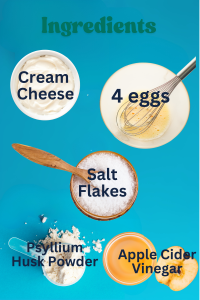
- Get things heated: Preheat your oven to 150°C (fan) or 170°C (conventional) / 300°F.
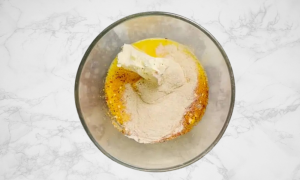
- Blend it all together: In a food processor, combine all ingredients. Pulse until a thick, sticky paste forms. Let the dough rest for 5 minutes.
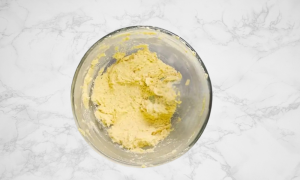
- Spread & roll: Divide the dough in two. Place one half on a sheet of baking paper. Flatten with a spatula, then cover with another sheet. Roll into a rectangle about 20x40 cm, aiming for 1–2 mm thickness. Don’t worry about perfect edges!
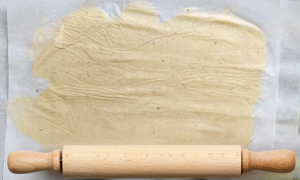
- Bake the sheets: Transfer to a tray, keeping the top paper on. Repeat with the second half. Bake each for 6–8 minutes until set.
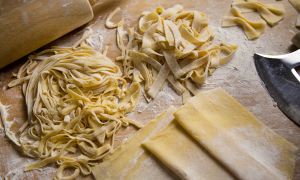
- Cool & cut: Remove the top sheet, let cool slightly, then roll the sheet from the short end. Use a sharp knife or pasta cutter to slice into wide ribbons (fettuccine-style).
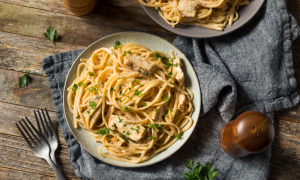
- Serve it up: Warm the pasta directly in your favorite sauce – no need to boil! Just stir through the hot sauce and serve.
- Thermomix Method
- Preheat oven as above.
- Add all ingredients to Thermomix bowl. Mix 20 sec / speed 5.
- Let rest for 5 minutes, then continue from step 3 above.
- Air Fryer Version
- Prepare and roll the dough to fit your air fryer.
- Bake at 150°C for 4–5 minutes per batch.
- Cool, roll, and slice as usual.
Video
Notes
- Eggs should be room temp to avoid an "eggy" flavor.
- Psyllium husk is essential for texture – don’t skip it!
- For a dairy-free version, swap cream cheese with mashed avocado.
🍝 Flavor Variations
- Spicy: Add 1–2 tsp chili flakes
- Green Goodness: Mix in ½–1 cup finely chopped spinach
- Curry Twist: Add 2 tsp curry powder
🧊 Storage & Serving
- Store cooked pasta in the fridge for up to 5 days or freeze for later.
- No boiling needed – simply heat in sauce before serving.
- Perfect for keto lasagna, pasta bakes, or even quick stir-fries.
Nutrition
Nutrition Disclaimer
Mom Keto by Emily Harper is not a dietician or nutritionist, and any nutritional information shared is an estimate. If calorie count and other nutritional values are important to you, we recommend running the ingredients through whichever online nutritional calculator you prefer. Calories can vary quite a bit depending on which brands were used.
